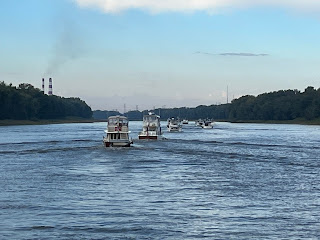We would have loved to stay on at Heritage for a few days but we needed to keep moving. At 6:45 the next morning, we left with our buddy boat Sea Clef and 4 other boats. Our first objective was Starved Rock Lock. We had been advised by the lock they would have to clear through a few commercial tows before we could lock through so we slowed down to 6 mph from our usual cruising speed of 9mph. Even with slowing down, when we arrived at the lock we were advised we would still have to wait. Our options at that point were to either drift in place or tie up to a "cell" (sometimes referred to as dolphins) near the lock. This would be a new experience for us. Cells are large round structures built into waterways, usually near dams, bridges, or locks. They are sometimes built to be used as a mooring site for boats. Other times they are constructed to prevent ships from accidentally damaging the structure they are protecting. In this case, the cell we were advised to tie up to was a circular structure, approximately 15 feet in diameter with a corrugated metal skin filled with concrete. There was a single eye in the middle to tie onto. Over the previous 6 months we had tied up to a variety of structures….. but never a round one. Fortunately, the current was not strong. After Karen hung a bunch of fenders near the middle of our hull, I was able to float us slowly up to this unforgiving metal structure and Karen was able to scamper off the boat and take one of our lines to the center eye. I was then able to pass her a second line. Once we were settled, Cam guided Sea Clef up to our side and rafted up with us. Not having been an avid boater for long, new experiences like this cause Karen a fair amount of anxiety. But she pulled it off like a pro and we could give ourselves a well-earned high five for a successfully tying our straight sided hull to an unforgiving round structure without so much as a scratch!
Within less than an hour after tying up, we got word from the lockmaster that we could proceed into the lock. We had a lot of company in the lock and we were rafted 4 deep. But it was an easy drop and, after exiting the lock, we proceeded down river to our destination for the night, the Henry Lock Wall.
Our next night was in Peoria Illinois at the Illinois Valley Yacht Club. We got there just in time to purchase the last few tickets to their annual Lobster Boil. Unfortunately, being the last folks to get tickets, we were the last to be served and we were still eating way past “Looper Midnight.” Peoria is the home of Caterpillar Tractors. We did not go, but we heard they have a great factory tour.
With a somewhat ominous weather report we set out the next morning with a group of Loopers for what would be our first night on anchor on the rivers. We dropped the hook behind Quiver Island near Havana, Illinois. The Anchor set well on the first try. Anchorages on the rivers are known for having a lot of debris on the bottoms that can snag anchors so we set the anchor with a “trip line” that would enable us to pull the anchor out backwards if needed. Although there are a variety of floats that can be used to locate the trip line, I figured an old plastic jug would work just as well and help me pass for a “good ole boy.” We could see barge traffic passing by on the river but we were set well back off the main river and the setting was quite peaceful. Sea Clef hosted “docktails” on their boat and later that night we had rain and an electrical storm show but, fortunately, very little wind.
We spent the next night on the docks of Mel’s Illinois Riverdock Restaurant and then continued on to Grafton, Illinois where the Illinois River ends and joins into the Mississippi! Grafton was the largest city we had seen since leaving Chicago 1 week before….wow- that was an interesting week. Grafton Harbor Marina was quite large and impressive. It was our first experience with covered docks. The Mississippi and Illinois rivers can have huge floods, with water levels rising 40ft or more. The whole marina was floating. Not just the docks…. even the restaurant, offices and pool were floating and the pilings that supported them were huge- over 40ft hi and 2ft in diameter. We spent 4 days in Grafton relaxing, swimming and hanging with other Loopers. We even took a chairlift up a hill to have lunch at a winery. There was an incredible view up there of the Mississippi and we got our first glimpse of the St. Louis arch in the distance, a site we were looking forward to seeing from the water!
































No comments:
Post a Comment